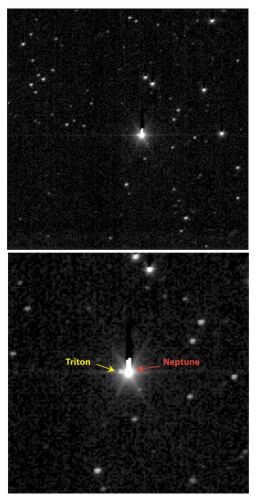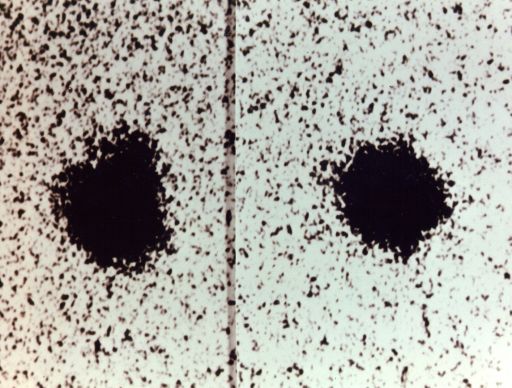Emily Lakdawalla • Mar 12, 2009
New Horizons spots Triton
Today the New Horizons team released photos captured by their high-resolution camera of the Neptune system, in which both Neptune and Triton were visible. Before you get too excited about the first observations of Triton since Voyager 2 flew by two decades ago, I should mention that New Horizons was really far away from Neptune at the time the photo was taken -- 3.75 billion kilometers away. To put this in context, New Horizons was actually more twice as far from Neptune than it was from Earth when it took the photo. That's really really far. So if you are hoping for a new photo of Triton's famed cantaloupe terrain, you're going to be disappointed.
What you should be excited about is the fact that New Horizons successfully separated Triton's light from Neptune's; according to the New Horizons release, the planet was 180 times as bright as the moon, as seen from the spacecraft. Here's the photo:

NASA / JHUAPL / SwRI
New Horizons spots Triton
This image represents a feat of astrophotography performed by New Horizons. The top frame is a composite, full-frame (0.29° by 0.29°) LORRI image of Neptune taken Oct. 16, 2008, using an exposure time of 10 seconds and 4-by-4 pixel re-binning to achieve its highest possible sensitivity. The bottom frame is a twice-magnified view that more clearly shows the detection of Triton, Neptune's largest moon. Neptune is the brightest object in the field and is saturated (on purpose) in this long exposure. Triton, which is about 16 arcsec east (celestial north is up, east is to the left) of Neptune, is approximately 180 times fainter. New Horizons was 3.75 billion kilometers from the Neptune system when this photo was taken.
USNO
Charon discovery image
Discovery images of Pluto's moon Charon. The images were captured with the 1.55-meter (61-inch) Kaj Strand Astrometric Reflector at the USNO Flagstaff Station. Both images are of Pluto. The right image appears round, but the left one has a noticeable lump to the upper right. The lump in the left image is Charon; in the right image Charon is located along the line of sight to Pluto and is thus invisible.Another good reason for New Horizons to photograph Triton, no matter how far away it is, is because Triton is the closest analog to Pluto and other Kuiper belt objects that we've ever seen; it's a chance for New Horizons to whet its appetite observing something with similar properties to its eventual science targets.
Another good reason is because New Horizons will be doing lots of observations of Pluto and other Kuiper belt objects from very, very far away, and taking this photo served as practice for the long exposures and steady tracking of faint and distant objects that will occupy it for so much of its primary mission. The steady tracking meant New Horizons could study Triton's light separately from Neptune's, much as it will eventually separate the faint light of Nix and Hydra from Pluto and Charon's, and possibly even study other, undiscovered satellites of the as-yet-undiscovered Kuiper belt objects that New Horizons goes on to investigate.
Support our core enterprises
Your support powers our mission to explore worlds, find life, and defend Earth. You make all the difference when you make a gift. Give today!
Donate

 Explore Worlds
Explore Worlds Find Life
Find Life Defend Earth
Defend Earth

